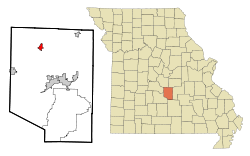2010 census
As of the census [9] of 2010, there were 1,110 people, 433 households, and 278 families residing in the city. The population density was 895.2 inhabitants per square mile (345.6/km2). There were 525 housing units at an average density of 423.4 per square mile (163.5/km2). The racial makeup of the city was 95.9% White, 0.5% African American, 0.8% Native American, 0.1% Asian, 0.5% from other races, and 2.3% from two or more races. Hispanic or Latino of any race were 2.8% of the population.
There were 433 households, of which 39.3% had children under the age of 18 living with them, 45.5% were married couples living together, 11.3% had a female householder with no husband present, 7.4% had a male householder with no wife present, and 35.8% were non-families. 31.6% of all households were made up of individuals, and 13.9% had someone living alone who was 65 years of age or older. The average household size was 2.55 and the average family size was 3.21.
The median age in the city was 33.5 years. 29.9% of residents were under the age of 18; 7.7% were between the ages of 18 and 24; 25.5% were from 25 to 44; 23.1% were from 45 to 64; and 13.6% were 65 years of age or older. The gender makeup of the city was 49.8% male and 50.2% female.
2000 census
As of the census [3] of 2000, there were 1,033 people, 425 households, and 277 families residing in the city. The population density was 868.4 inhabitants per square mile (335.3/km2). There were 517 housing units at an average density of 434.6 per square mile (167.8/km2). The racial makeup of the city was 97.29% White, 0.29% African American, 1.36% Native American, 0.39% Pacific Islander, 0.10% from other races, and 0.58% from two or more races. Hispanic or Latino of any race were 0.68% of the population.
There were 425 households, out of which 36.2% had children under the age of 18 living with them, 49.4% were married couples living together, 11.1% had a female householder with no husband present, and 34.8% were non-families. 32.5% of all households were made up of individuals, and 15.8% had someone living alone who was 65 years of age or older. The average household size was 2.41 and the average family size was 3.04.
In the city the population was spread out, with 28.4% under the age of 18, 8.2% from 18 to 24, 29.4% from 25 to 44, 16.9% from 45 to 64, and 17.0% who were 65 years of age or older. The median age was 36 years. For every 100 females there were 89.9 males. For every 100 females age 18 and over, there were 85.5 males.
The median income for a household in the city was $29,583, and the median income for a family was $35,750. Males had a median income of $26,964 versus $16,141 for females. The per capita income for the city was $13,401. About 13.9% of families and 17.5% of the population were below the poverty line, including 22.1% of those under age 18 and 19.2% of those age 65 or over.

